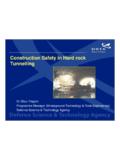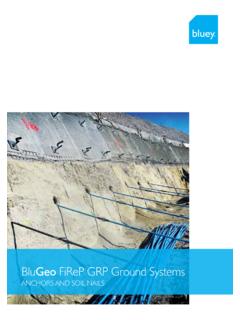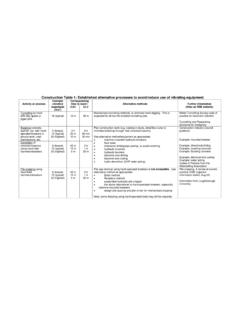Transcription of JACKED BOX TUNNELLING - Norwich Engineering …
1 JACKED BOX TUNNELLING Using the Ropkins SystemTM, a non-intrusive TUNNELLING technique for constructing new underbridges beneath existing traffic arteries DR DOUGLAS ALLENBY, Chief TUNNELLING Engineer, Edmund Nuttall Limited JOHN W T ROPKINS, Managing Director, John Ropkins Limited Lecture presented at the Institution of Mechanical Engineers Held at 1 Birdcage Walk, London On Wednesday 17 October 2007 Institution of Mechanical Engineers 2007 This publication is copyright under the Berne Convention and the International Copyright Convention.
2 All rights reserved. Apart from any fair dealing for the purpose of private study, research, criticism or review, as permitted under the Copyright, Designs and Patent Act, 1988, no part of this publication may be reproduced, stored in a retrieval system or transmitted in any form or by any means without the prior permission of the copyright owners. Reprographic reproduction is permitted only in accordance with the terms of licenses issued by the Copyright Licensing Agency, 90 Tottenham Court Road, London W1P 9HE. Unlicensed multiple copying of the contents of the publication without permission is illegal.
3 JACKED Box TUNNELLING using the Ropkins SystemTM, a non-intrusive TUNNELLING technique for constructing new underbridges beneath existing traffic arteries Dr Douglas Allenby BSc(Hons) PhD CEng FICE FIMechE FGS, Chief TUNNELLING Engineer, Edmund Nuttall Limited John W T Ropkins BSc CEng MICE, Managing Director, John Ropkins Limited The Ropkins SystemTM is a non-intrusive TUNNELLING technique that enables engineers to construct underbridges beneath existing traffic arteries in a manner that avoids the cost and inconvenience of traffic disruption associated with traditional construction techniques.
4 The paper outlines a TUNNELLING system designed to install large open ended rectangular reinforced concrete box structures at shallow depth beneath existing railway and highway infrastructure. The system provides measures to control ground movements around the advancing box so that movements of overlying and adjacent infrastructure are minimised and maintained within acceptable limits. Application of the technique to three projects in the UK is described at Silver Street railway station, Edmonton, London, under the London to Bristol railway at Dorney, Berkshire, and under the M1 Motorway at Junction 15A, Northampton.
5 The influence of site specific conditions and hazards on the design of the TUNNELLING system adopted is noted together with the performance achieved in practice. Consideration is given to the manner in which the Ropkins SystemTM should be selected, developed and executed. The importance of a comprehensive investigation of the ground conditions and infrastructure at the site of the works is stressed together with the need for a client to engage the services of a specialist engineer and specialist contractor experienced in the Ropkins SystemTM.
6 Key words: Ropkins SystemTM; JACKED box TUNNELLING ; TUNNELLING ; underbridges; infrastructure; geotechnical 1. INTRODUCTION TO THE TUNNELLING TECHNIQUE Figure 1 illustrates the first underbridge installed under a live motorway in the UK at Junction 15A of the M1 Motorway. The underbridge measures 14m wide, high by 45m long and was cast as an open ended monolithic reinforced concrete box on a jacking based constructed adjacent to the motorway embankment as illustrated in Figure 2(a). A purpose designed cellular tunnel shield was provided at its leading end with thrust jacks mounted at its trailing end reacting against the jacking base.
7 Internal equipment included face excavation and spoil handling equipment, ventilation fans and ducting, essential services and rear access for personnel. Top and bottom proprietary anti-drag systems were installed to minimise both ground drag and friction developed on the extrados/ground interface during box installation; these are described in Section 2. The box was then JACKED to the embankment and entered through the headwall into the ground using a carefully controlled and phased sequence.
8 TUNNELLING commenced by carefully excavating 150mm off the face and jacking the box forward a corresponding increment, this sequence being repeated many times [Figure 2(b)]. On the exit side of the embankment a temporary berm was constructed to buttress the embankment during the final stages of jacking. When the shield had reached its final position [Figure 2(c)] the shield and all internal and jacking equipment were dismantled and removed, the box extrados/ground interface grouted, portal wing walls, parapets and roadway constructed, internal services installed and the underbridge opened to traffic [Figure 2(d)].
9 The technique is suitable for use in many types of ground, both natural and made ground, where face stability can be controlled using open faced shield TUNNELLING methods. On some projects ground conditions have been improved by geotechnical processes such as dewatering, grouting or artificial ground freezing in order to render them suitable for JACKED box TUNNELLING [Table 1]. In all cases a comprehensive, site specific, site investigation and archive survey is essential to identify the ground types, their strength and stability characteristics, and the ground water regime.
10 Surveys of overlying infrastructure are essential to establish infrastructure type, form, structural integrity and ability to withstand displacements. Using this information the specialist engineer will design a fully integrated TUNNELLING system comprising tunnel shield and excavation method, spoil handling, jacking system, anti-drag systems and jacking base together with the embankment headwall entry and exit procedures. Risk assessments form an essential part of this process.






